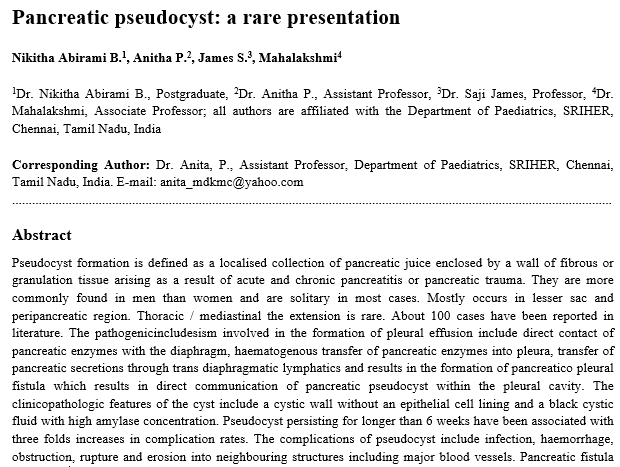Pancreatic pseudocyst: a rare presentation
Abstract
Pseudocyst formation is defined as a localised collection of pancreatic juice enclosed by a wall of fibrous or granulation tissue arising as a result of acute and chronic pancreatitis or pancreatic trauma. They are more commonly found in men than women and are solitary in most cases. Mostly occurs in lesser sac and peripancreatic region. Thoracic / mediastinal the extension is rare. About 100 cases have been reported in literature. The pathogenicincludesism involved in the formation of pleural effusion include direct contact of pancreatic enzymes with the diaphragm, haematogenous transfer of pancreatic enzymes into pleura, transfer of pancreatic secretions through trans diaphragmatic lymphatics and results in the formation of pancreatico pleural fistula which results in direct communication of pancreatic pseudocyst within the pleural cavity. The clinicopathologic features of the cyst include a cystic wall without an epithelial cell lining and a black cystic fluid with high amylase concentration. Pseudocyst persisting for longer than 6 weeks have been associated with three folds increases in complication rates. The complications of pseudocyst include infection, haemorrhage, obstruction, rupture and erosion into neighbouring structures including major blood vessels. Pancreatic fistula and ascitis result when there is leakage or rupture of pseudocyst into the abdominal cavity. Repeated pleural effusion presumably resulting from rupture and fistulation from pancreatic duct initial account the pleural cavity. Such presentation account for less than 3 % of cases and even rarer to be an asymptomatic event. Resection is the optimal treatment for persistent leakage from the tail of pancreas. The diagnosis requires the careful integration of many historical, radiographic, laboratory, and other factors, and management is markedly different depending on the type, location and size of cystic lesion of pancreas. We report this case of rare location of pseudocyst i.e. thoracoabdominal without any ductal communication.
Downloads
References
Lankisch PG, Dröge M, Becher R. Pleural effusions: A new negative prognostic parameter for acute pancreatitis. Am J Gastroenterol. 1994;89(10):1849-1851.
Uchiyama T, Suzuki T, Adachi A, Hiraki S, Iizuka N. Pancreatic pleural effusion: Case report and review of 113 cases in Japan. Am J Gastroenterol. 1992;87(3):387-391.
Yeo CJ. Pancreatic pseudocysts, ascites and fistulas. Curr Opin Gen Surg. 1994;173-178.
Bradley EL. Complications of chronic pancreatitis. Surg Clin North Am. 1989;69(3):481-497. doi: https://doi.org/10.1016/s0039-6109(16)44832-2.
Lillemore KD, Yeo CJ. Management of complications of pancreatitis. Curr Problems Surg. 1998;54(3):1-98. doi: https://dx.doi.org/10.1136%2Fgut.2003.035907.
Sumalata C, Gopichand N. An unusual presentation of pancreatic pleural effusion. Sch JMed Case Rep. 2014;2(9):612-614. Available at http://saspjournals.com/wp-content/uploads/2014/09/SJMCR-29612-614.pdf.
Bradley EL, Clements JL, Jr, Gonzalez AC. The natural history of pancreatic pseudocysts: a unified concept of management. Am J Surg. 1979;137(1):135-141. doi: https://doi.org/10.1016/0002-9610(79)90024-2.
Warshaw AL, Rattner DW. Timing of surgical drainage for pancreatic pseudocyst. Clinical and chemical criteria. Ann Surg. 1985;202(6):720-724. doi: https://doi.org/10.1097/00000658-198512000-00010.
Shatney CH, Lillehei RC. The timing of surgical treatment of pancreatic pseudocysts. Surg Gynecol Obstet. 1981;152(6):809-812.
Sankaran S, Walt AJ. The natural and unnatural history of pancreatic pseudocysts. Br J Surg. 1975;62(1):37-44. doi: https://doi.org/10.1002/bjs.1800620110.
Ravikiran Shankar kamble, Rahulkumar Gupta, Abhaya R Gupta. Thoracoabdominal pseudocyst of pancreas. World J Gastrointest Surg. 2015;7(5):82-85.doi: https://doi.org/10.4240/wjgs.v7.i5.82.
Rose E A, Haider M, Yang SK, Telmos A J. Mediastinal extension of a pancreatic pseudocyst. Am J Gastroenterol 2000;95(12):3638-3639. doi:https://doi.org/10.1111/j.1572-0241.2000.03387.x.

Copyright (c) 2020 Author (s). Published by Siddharth Health Research and Social Welfare Society

This work is licensed under a Creative Commons Attribution 4.0 International License.


 OAI - Open Archives Initiative
OAI - Open Archives Initiative


